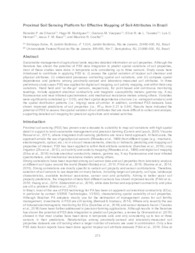Proximal soil sensing platform for effective mapping of soil attributes in Brazil.
Proximal soil sensing platform for effective mapping of soil attributes in Brazil.
Autoria: OLIVEIRA, R. P. de; RODRIGUES, H. M.; VASQUES, G. de M.; TAVARES, S. R. de L.; HERNANI, L. C.; BACA, J. F. M.; COELHO, M. R.
Resumo: Sustainable management of agricultural lands requires detailed information on soil properties. Although the literature has shown the potential of PSS data integration to predict spatial variations of soil properties, most of these studies were done in temperate soils considering up to three sensors. Study cases here introduced to contribute in applying PSS to: (i) assess the spatial variation of tropical soil chemical and physical attributes; (ii) understand processes controlling spatial soil variations; and (iii) compare spatial dependence and patterns among proximally-sensed and laboratory-measured soil attributes. In three preliminary study cases PSS was applied for digital soil mapping, soil salinity mapping, and within-field crop variations. Hand held and "on-the-go" sensors, respectively, for point-based and continuous monitoring readings, include apparent electrical conductivity and magnetic susceptibility meters; gamma ray, X-ray fluorescence and near infrared spectrometers; and mechanical resistance meters among others. Variables were significantly correlated (p < 0.05), and their spatial dependence structure (i.e: variogram analysis) and the spatial distribution patterns (i.e.: kriging) were all-similar. In addition, combined PSS datasets have shown improved predictions of soil properties (i.e.: R2adj. from 0.21 to 0.94). Results have indicated the potential of PSS to assess the spatial variation of soil attributes that are more difficult to collect and analyze, supporting detailed soil mapping for precision agriculture and related activities.
Ano de publicação: 2019
Tipo de publicação: Artigo em anais e proceedings
Unidade: Embrapa Solos
Observações
1 - Por padrão são exibidas publicações dos últimos 20 anos. Para encontrar publicações mais antigas, configure o filtro ano de publicação, colocando o ano a partir do qual você deseja encontrar publicações. O filtro está na coluna da esquerda na busca acima.
2 - Para ler algumas publicações da Embrapa (apenas as que estão em formato ePub), é necessário ter, no celular ou computador, um desses softwares gratuitos. Sistemas Android: Google Play Livros; IOS: iBooks; Windows e Linux: software Calibre.
Acesse outras publicações
Acesse a Base de Dados da Pesquisa Agropecuária (BDPA) para consultar o acervo completo das bibliotecas da Embrapa.

